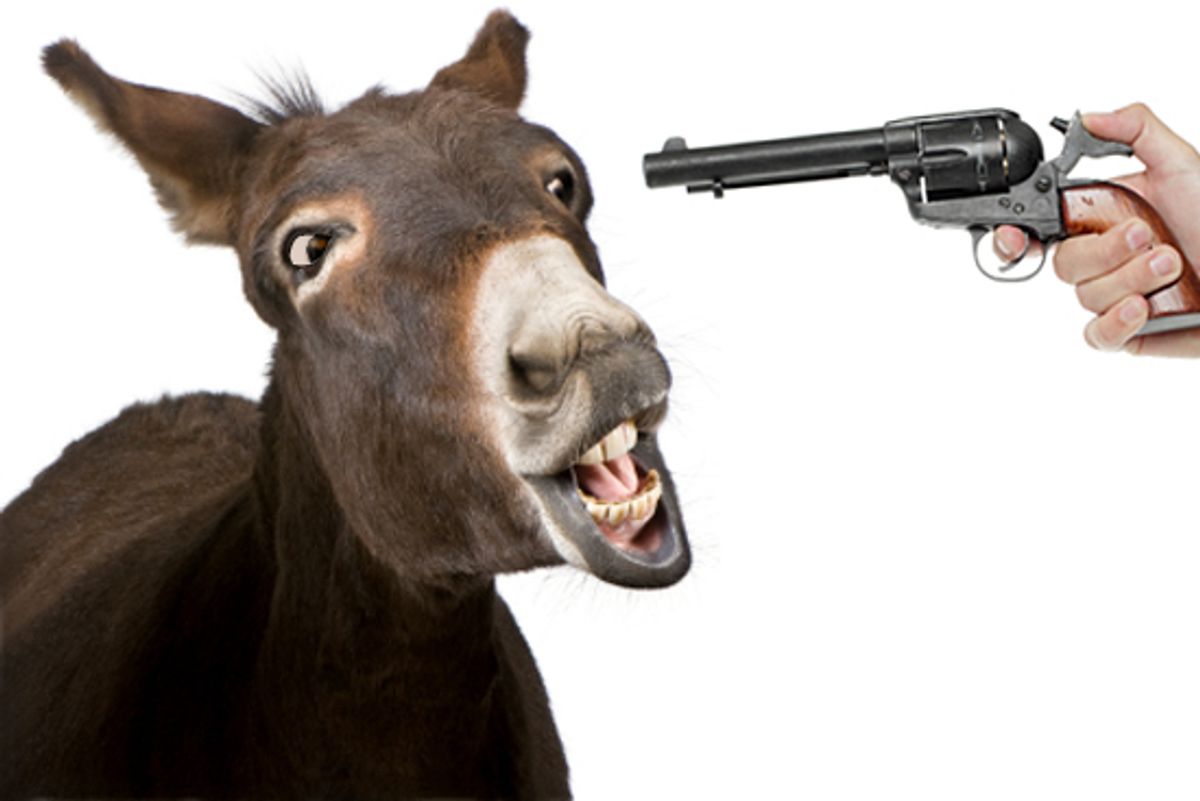On the heels of yet another gloomy jobs report and a slew of polls showing President Obama and his party losing broad support across the country, dread has begun to set in among Democrats that a Republican takeover of the House is inevitable.
In thinking about how Democrats could improve their increasingly grim November outlook, the iconic 1973 cover of National Lampoon magazine -- in which a hand holds a revolver up to a worried-looking dog beside a caption threatening the reader to buy the current issue or else -- comes to mind.
In fact, it seems the White House may be embracing this thinking. Both Robert Gibbs, the White House press secretary, and David Plouffe, Obama's old campaign manager, have recently stated that a new Republican majority is possible. While their comments were immediately assailed by the party's House leadership, they actually revealed a shrewd strategy: pushing the panic button to spur unengaged Democrats to counter the flood of Republican-leaning voters expected in November.
This may be Democrats’ best hope of salvaging a respectable showing in a brutal electoral cycle -- and staving off another 1994.
The numbers right now are foreboding. Aside from Obama’s own approval rating, which is steadily falling, Democrats in general have been unable to bring up their own numbers. Specifically, their standing in the generic congressional ballot has been anemic, with two polls from the last several weeks each showing Democrats down 6 points and a third putting the deficit at 8.
Not that this is entirely unexpected, of course. The party out of power generally makes a comeback following a presidential loss, as the midterms in 1978, 1982 and 1994 attest. But the Democrats’ problems have manifested themselves in two critical ways.
First, Republican enthusiasm is far stronger than that for Democrats. An early July poll by Pew found that the enthusiasm gap between the two parties is even wider now than it was in 1994, and in late June, Gallup found that 59 percent of Republican-leaning voters were more enthusiastic about the midterms than usual, compared to just 44 percent for Democrats.
Gallup also revealed this month that independents prefer supporting a Republican congress member by a 45 to 35 percent spread, consistent with the healthy advantage the GOP has enjoyed all year.
In layman's terms, independents have turned against Democrats -- unlike in 2008, when Obama won indies by 52-44 -- and Republicans are eager to come out in force in November, while many Democrats remain unexcited.
The lack of Democratic energy can be attributed to a host of factors, including: disappointment among Obama’s diverse electoral coalition that he hasn't delivered what was expected; anger at congressional Democrats for not being able to overcome Republican intransigence; the natural voter fatigue that follows a string of election successes; and simple uncertainty with the economy.
For Democrats, winning over many Republicans this fall is out of the question at this point. And unless the economy drastically improves, they can also forget gaining significant ground with independents, who often vote their pocketbooks. This leaves only the Democratic base, which even today, with all of Obama's weaknesses, remains larger than the Republican base in terms of self-identified voters. In other words, the voters are there for Democrats, but they might not come out in November.
But jolting Democrats is tricky. There are signs that swing voters in several close Senate races are less likely to back a candidate supported by Obama. Thus, the president, whose presence could help motivate the party base, will be inhibited from campaigning for many Democrats in the fall.
Given the broad Democratic malaise that persists -- despite impressive legislative triumphs including overhauling the healthcare system, passing a massive stimulus package, and reaching the cusp of enacting comprehensive financial sector reform -- national Democrats’ options for turning out their base at this point are limited. This is precisely why, with Election Day less than four months away, sounding alarm bells about Republicans possibly taking back Congress makes the most sense as a mobilizing instrument.
While Democrats should continue to run on their ideas and accomplishments, they need to begin focusing heavily on the possibility of Republicans taking back power. Many of them may not want to appear fearful on the trail -- Speaker Nancy Pelosi and other Democrats are reportedly furious at the White House for providing Republicans with what they feel is a potent talking point as well as potentially hindering their critical fundraising push -- but numbers don’t lie: Their majority is in peril. This may be the most powerful tonic to wake up comatose or jittery rank-and-file Democrats, who helped elected Obama and the current congressional majorities. Get them activated and it could limit Democrats' losses and preserve their control of Capitol Hill.
Given their bleak position and dearth of options, what do Democrats have to lose by pressing the panic button?



Shares